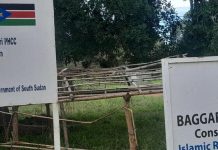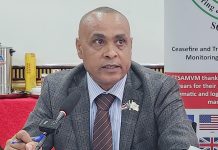Majok Deng
Africa-Press – South-Sudan. By age and population, the Federal Republic of Nigeria and the Republic of South Sudan are totally two different countries. Essentially, Nigeria is one of the oldest countries in Africa that achieved its independence from the British in 1960, making it four years younger than the old Sudan.
It is also one of the most populous countries in Africa, with a population of around 220 million people. On the other hand, South Sudan is one of the youngest countries in Africa that gained its independence from Sudan after more than two decades of civil war with the Khartoum-led regime in 2011.
It has an estimated population of more than 12 million people. Both countries are oil-exporting countries in Africa and have been grappling with terrible currency depreciation. Furthermore, just like in South Sudan, more than 90 percent of Nigeria’s export revenues also come from oil exports to an international market.
Nigeria has been experiencing currency depreciation since independence. The Naira was trading at N 1,415 per US dollar in the black market and also trading at N 892 at the official window as of January 31, 2024, according to a Bloomberg report.
Meanwhile, the SSP was trading at around SSP 1,200 per US dollar in the black market and trading at around SSP 1,108 per US dollar according to the official Central Bank rate. And, according to analysts, both currencies are expected to depreciate further if policymakers do not adopt appropriate policies.
Therefore, it is necessary to look at what Nigeria has done wrong to avoid going down the same path. So far, both the price of SSP and the Naira are moving in tandem in terms of the USD. And, since Nigeria has never redenominated its currency since 1960, it tells you how fast we have caught up with Nigeria in its economic trajectory.
This must give our government reason to worry about the future of our symbol of economic sovereignty, the SSP. If we don’t take decisive, bold actions now, we will be struggling with unimaginable economic problems in the next 30 years.
In fact, continuous currency depreciation in the Naira has been caused by out-of-control federal government borrowing from the Central Bank of Nigeria (CBN) via a way and means window. Just like the case of the Bank of South Sudan Act (2023) (BOSS), the CBN’s advance to the federal government is limited by law to 5 percent of the previous year’s government revenues. However, this legal benchmark has been breached in both countries.
For instance, as of December 2023, the Nigerian government has decided to convert its 23.7 trillion naira –equivalent to 53 billion US dollars—loan it owes to the CBN into a long-term debt. In South Sudan, the finance ministry’s outstanding obligation to the BOSS stood at SSP 499 billion as of August 2023.
These obligations may have already been converted to long-term debts since the Central Bank Act requires these loans to be paid back within three months before another line of accommodation could be issued by the apex bank.
This exercise has caused an unprecedented and exponential rise in money supply and caused currency depreciation in both countries. That said, these countries have gone against the conventional wisdom in economics that barred deficit financing via high-powered money.
This brings me to the second cause of currency depreciation in both countries and that is the mismatch between the supply of foreign currency and the local currencies or a mismatch between the supply and the demand of the greenback in the local FX market.
First and foremost, before the adoption of fiat currencies across the world in 1970, domestic currencies were pegged to gold. That means countries were allowed to print local currencies equivalent to the value of their gold reserves.
But since then, countries like Nigeria and South Sudan where governments do not worry much about the consequences of inflation on their population have been able to print local currencies as much as they want to finance the budget deficit. This has caused a mismatch between the quantity of local currency and dollars circulating in the economy and weakened domestic currencies in the FX market as a result.
Furthermore, these countries derive most of their foreign exchange (FX) from the export of oil to the international market. Consequentially, volatility in oil prices has often come with periods of low FX inflow that cannot meet import bills.
This is because these countries import nearly everything from neighbouring countries. As a result, in a period of low FX inflow compared to FX outflow via the import of goods and services, both the SSP and Naira had to depreciate vis-à-vis the greenback.
The scarcity of FX has been exploited by speculators who have been engaging in arbitrage through the buying and selling of scarce foreign currency. On the demand side of the equation, you have importers, tenants, parents with children who are studying abroad, local travellers via airline companies, hospitality industry users, and arbitrageurs, but only on the supply side, you have government oil receipts and diaspora remittances.
And even the government oil receipts are not fully remitted to the central bank accounts in both countries. This has also caused high demand for the greenback in the FX market, leading to the depreciation of local currencies.
Generally speaking, these economies are partially dollarized, which renders the use of conventional monetary policy tools almost ineffective. That being said, central bank governors have found themselves with no tools to respond to speculators. But as they found themselves under pressure from politicians who expected instantaneous change, some of them resorted to the use of unorthodox tools.
For instance, the CBN, under its ex-governor, Mr. Godwin Emefiele, had decided to cut down trees along the street of Lagos, where black marketers sheltered under their shade as they traded local currencies for the greenback. In South Sudan, the incumbent BoSS Governor, Dr. James Alic, had ordered for reorganisation of the informal FX dealers. The local currencies are traded on the streets by currency dealers in both countries. But despite their good intentions, the local currencies have continued to underperform vis-à-vis their peers in the region.
In a nutshell, solutions to the perennial economic crisis in both countries are easier said than done. First and foremost, there is a need for economic diversification in order to increase the source of FX earnings.
Diversification of economy has been the gospel truth in Nigeria, since 1960, but it has not moved an inch in that regard. So, I am afraid we are going the Nigerian way because we have been singing the same song (economic diversification) in South Sudan since 2012. Moreover, Nigeria has of late realised the importance of channelling oil sales proceeds to the Central Bank so it can build its forex reserves, but it is not going to succeed due to resistance from people with strong vested interests. In South Sudan, we have been grappling to implement the Treasury Single Account since 2017, which serves a similar purpose to that of Nigeria. Indeed, all this can be achieved if the central bank governors choose to challenge the status quo. Unfortunately, the central banks’ chiefs have turned to the use of fundamental textbook economics. That being said, the BOSS governor, Dr. James Alic and the CBN governor, Mr. Olayemi Cardoso, have announced their plans to modernise central bank communications hoping that constant communications with the general public may turn things around for struggling economies.
Source: The City Review South Sudan
For More News And Analysis About South-Sudan Follow Africa-Press






